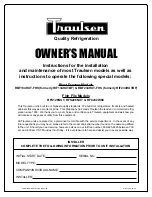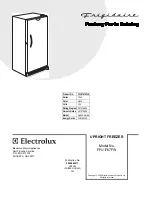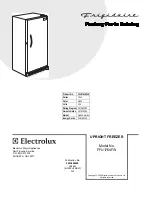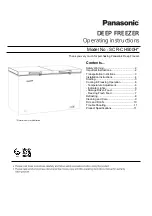
-9-
X. CARE OF STAINLESS STEEL (cont
’
d)
X. c - CLEANING SUMMARY - DO
’
S & DONT
’
S:
To summarize the proper cleaning of Traulsen refrigeration
products, always follow the below guidelines.
DO
use only cleaning products designed for
stainless steel, or cleaning products which do
not contain chlorides.
DO
use only non-abrasive cleaning materials, such
as soft cloths or plastic scouring pads.
DO
clean-up food and beverage spills ASAP.
DO
scrub only in the direction of the grain when
using soft nylon scouring pads.
DON
’
T use chlorinated cleansers or cleansers
containing quaternary salts.
DON
’
T use abrasive cleaning materials or tools
which can scratch the stainless steel
’
s surface.
X. d - DEALING WITH ACCIDENTAL CHLORIDE CONTACT:
In the daily routine of a busy foodservice operation, your
Traulsen refrigeration product may occasionally come in
contact with chlorinated cleaners, such as when being
splashed during mopping. Stain and corrosion problems
resulting from this can be avoided by prompt action to re-
move this cleanser. Rinse the affected area(s) thoroughly
with cool, clean water (do not use hot water) and wipe com-
pletely dry using a paper towel or soft absorbent cloth.
X. e - PROTECTING THE STAINLESS STEEL SURFACE:
Occasional use of a commercial stainless steel polish, such
as “Sheila Shine,” will help protect the surface of stainless
steel. Follow the directions on the spray can for proper
use.
XI. CORROSION REMEDIES
XI. a - DEALING WITH RUST AFTER THE FACT:
Although Traulsen strongly recommends proper care and
cleaning of stainless steel finishes in order to avoid rust
and corrosion before it occurs, we recognize that it may
occur occasionally as a result of the causes described in
section one of this booklet.
To remove small quantities of rust from the surface of stain-
less steel, it is far preferable to deal with this when it first
becomes visible. When rust occurs, do not allow it to re-
main for any period of time, and remove it using the follow-
ing method:
STEP ONE - Use a lightly abrasive compound (free of harm-
ful chlorides), such as
“
Bon Ami,
”
on a soft cloth, to re-
move the rust. Care must be taken to rub this on the area
of rust only in the direction of the stainless steel’s grain.
XI. CORROSION REMEDIES
XI. a - DEALING WITH RUST AFTER THE FACT (cont
’
d):
STEP TWO - Once the rust is removed, clean the affected
area thoroughly with a stainless steel cleaner (see sections
II. a & b).
STEP THREE - Apply a preservative polish, such as “Sheila
Shine,” to the affected area (see section II. e).
XI. b - DEALING WITH EXTREME RUST SITUATIONS:
In the event that rust and corrosion were not dealt with
promptly, more acute situations can be remedied as fol-
lows:
NOTE: PROCEDURE REQUIRES USE OF AN ACID BASED
SOLUTION - USE OF PROTECTIVE GLOVES AND
EYEWEAR ARE REQUIRED BEFORE PROCEEDING
STEP ONE - In a clean spray bottle combine water with
“
Zep
FS Lime Remover
”
to make a 5 parts to 1 solution.
STEP TWO - Apply this solution to the affected area with
either a clean cloth or sponge.
STEP THREE - After application, wipe the same area thor-
oughly clean with water only to remove any residue.
STEP FOUR - Once cleaned, apply a light coat of
“
Zep Re-
store
”
to the surface area. This will serve to preserve the
metal and help prevent future rust from occuring.
STEP FIVE - Restore the remaining stainless steel surfaces
to their original shine using
“
Zep Stainless Steel Polish.
”
Repeat steps one thru five if necessary for stubborn rust
and corrosion areas.
XI. c - RESTORING THE PROTECTIVE LAYER:
There are several products available on the market today
which can actually help restore the
“
PASSIVATION
”
of stain-
less steel.
“
PASSIVATION
”
refers to the protective quali-
ties of the non-reactive surface layer of stainless steel which
prevents oxidation. Contact your cleaning supplier for prod-
uct recommendations and more information.






























